
Storage tanks come in various sizes and serve as containers for storing liquids, making them available for use as needed. These tanks, commonly known as water tanks, are made from materials such as polyethylene, polyester, and stainless steel. Karmod Plastic, known for its quality materials and extensive experience in producing polyester underground water tanks, offers water tanks tailored to various needs. However, what should you pay attention to when buying these storage tanks? Let's take a closer look together.
The first and foremost consideration is the nature of the liquid or food you intend to store. If you plan to store food, it's essential to consider the specific nature of that food. For instance, if you plan to store pickles, it's better to use tanks specifically designed for pickles. Since pickles are acidic in nature, storage tanks have been designed to suit these types of food. On the other hand, if you need to keep something cool after storing it, you may prefer stainless steel tanks. Cooling can lead to condensation outside the tank. To prevent this and ensure that the tank is not affected by the external environment, stainless steel tanks are a more suitable option. By sharing the details of the substance, you want to cool and your cooling method with Karmod Plastic's expert engineers, you can select the right tank.
The most critical aspect to consider when choosing a tank, as we've previously mentioned, is the substance that will be stored inside. For home use, affordable, relatively small-sized polyethylene tanks are suitable. However, these tanks are also widely used in factories to store certain chemicals. If you plan to store a chemical substance or mixture, providing information about the chemical substance you intend to store will help you select a tank that does not react with the substance. Moreover, it is important to label tanks storing such chemicals. Labels are essential for protecting the content of the tank and for educating personnel working with the tanks.
Speaking of chemicals, some chemicals can release heat. In this case, labels like "Keep Away from Heat" can be attached to the tanks. It's crucial to choose a tank that is resistant to heat in such circumstances. Polyethylene water tanks, for example, can withstand temperatures of up to 60 degrees. If the chemical you want to store emits heat exceeding 60 degrees, opting for different types of tanks would be more appropriate. Additionally, these kinds of chemicals can release gases into the tank. In such cases, tanks made of stainless steel might be a better choice.
Apart from these considerations, there are also underground tanks. These tanks are typically used for storing liquids that either need to remain cool or are financially valuable. Examples include fuel or diesel. An underground tank is placed underground with a concrete cage, which isolates it from the effects of the surrounding soil. Since the top portion remains above ground, filling the tank is convenient. When you need to access the liquid inside the tank, you can use a discharge valve connected to a pipe. The connection of the discharge pipe to the outside is established before the tank is placed underground. Afterward, the top is covered with concrete, protecting the tank from soil bacteria and fungi.


 EN
EN
 DE
DE
 FR
FR
 IT
IT
 ES
ES
 PT
PT
 RU
RU
 AR
AR
 BG
BG
 SR
SR
 GR
GR
 SQ
SQ
 RO
RO
 PL
PL
 HU
HU
 CZ
CZ
 HR
HR
 AZ
AZ
 GE
GE
 AM
AM
 IL
IL